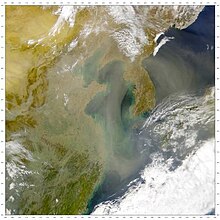Asian Dust
| Yellow Dust | |||||||||||||||||||||||||||||

Dust clouds leaving mainland China and traveling toward Korea and Japan.
|
|||||||||||||||||||||||||||||
| Chinese name | |||||||||||||||||||||||||||||
|---|---|---|---|---|---|---|---|---|---|---|---|---|---|---|---|---|---|---|---|---|---|---|---|---|---|---|---|---|---|
| Traditional Chinese | |||||||||||||||||||||||||||||
| Simplified Chinese | 沙 | ||||||||||||||||||||||||||||
|
|||||||||||||||||||||||||||||
| Vietnamese name | |||||||||||||||||||||||||||||
| Vietnamese | bão cát vàng | ||||||||||||||||||||||||||||
| Korean name | |||||||||||||||||||||||||||||
| Hangul | 황사 | ||||||||||||||||||||||||||||
| Hanja | 黃沙 or 黃砂 | ||||||||||||||||||||||||||||
|
|||||||||||||||||||||||||||||
| Japanese name | |||||||||||||||||||||||||||||
| Kanji | 黄 | ||||||||||||||||||||||||||||
| Kana | こうさ | ||||||||||||||||||||||||||||
|
|||||||||||||||||||||||||||||
| Transcriptions | |
|---|---|
| Standard Mandarin | |
| Hanyu Pinyin | Huángshā |
| Bopomofo | ㄏㄨㄤˊ ㄕㄚ |
| Wade–Giles | huang2 sha1 |
| Tongyong Pinyin | huang2 sha1 |
| Wu | |
| Romanization | waon平 so平(Wuu Pinyin) IPA: [ɦuaŋ so] |
| Hakka | |
| Romanization | vong11 sa24 |
| Yue: Cantonese | |
| Jyutping | wong4 sa1 |
| Southern Min | |
| Hokkien POJ | hong2 sê1 |
| Transcriptions | |
|---|---|
| Revised Romanization | Hwangsa |
| McCune–Reischauer | hwang-sa |
| Transcriptions | |
|---|---|
| Revised Hepburn | kōsa |
| Kunrei-shiki | kôsa |
| Nihon-shiki | kôsa |
Asian Dust (also yellow dust, yellow sand, yellow wind or China dust storms) is a meteorological phenomenon which affects much of East Asia year round but especially during the spring months. The dust originates in the deserts of Mongolia, northern China and Kazakhstan where high-speed surface winds and intense dust storms kick up dense clouds of fine, dry soil particles. These clouds are then carried eastward by prevailing winds and pass over China, North and South Korea, and Japan, as well as parts of the Russian Far East. Sometimes, the airborne particulates are carried much further, in significant concentrations which affect air quality as far east as the United States.
Since the turn of the 21st Century it has become a serious problem due to the increase of industrial pollutants contained in the dust and intensified desertification in China causing longer and more frequent occurrences, as well as in the last few decades when the Aral Sea of Kazakhstan and Uzbekistan started drying up due to the diversion of the Amu River and Syr River following a Soviet agricultural program to irrigate Central Asian deserts, mainly for cotton plantations.
Sulfur (an acid rain component), soot, ash, carbon monoxide, and other toxic pollutants including heavy metals (such as mercury, cadmium, chromium, arsenic, lead, zinc, copper) and other carcinogens, often accompany the dust storms, as well as viruses, bacteria, fungi, pesticides, antibiotics, asbestos, herbicides, plastic ingredients, combustion products as well as hormone mimicking phthalates. Though scientists have known that intercontinental dust plumes can ferry bacteria and viruses, "most people had assumed that the [sun's] ultraviolet light would sterilize these clouds," says microbiologist Dale W. Griffin, also with the USGS in St. Petersburg, "We now find that isn't true."
...
Wikipedia
